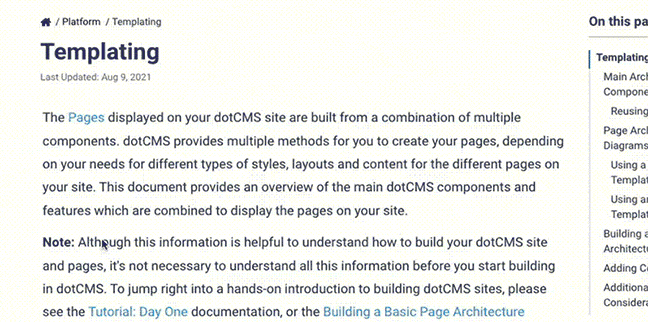All of the field types for Content contribution on a dotCMS instance are Types of Content are defined by Webmasters with customized field types to allow content contributors to create content on a dotCMS managed site. The standard field types may include:
Field Types
| Display Type | Data Type | Description |
|---|---|---|
| Text | Text | Single line text with no formatting tools available to content contributors |
| Textarea | Text | Multi-line text with no formatting tools available to content contributors |
| WYSIWYG | Text | Multi-line text which can be easily formatted by content contributors |
| Radio | Selection (Single) | Allows selection of a single value from a set of pre-defined text values |
| Select | Selection (Single) | Allows selection of a single value from a set of pre-defined text values |
| Checkbox | Selection (Multiple) | Allows selection of zero, one, or multiple values from a set of pre-defined text values |
| Multi-select | Selection (Multiple) | Allows selection of zero, one, or multiple values from a set of pre-defined text values |
| Date | Date and Time | Date (only) |
| Date/time | Date and Time | Date and Time |
| Time | Date and Time | Time (only) |
| Site or Folder | Location | Enables each individual content item to be located in (and to inherit permissions from) a separate site or folder |
| Binary | File | File or image embedded in, and accesible only to, the content it is added to |
| Image | File | Link to an image which can be accessed separately from the content (via the Site Browser) |
| File | File | Link to a file which can be accessed separately from the content (via the Site Browser) |
| Category | Taxonomy | Allows content contributors to select from a pre-defined list of Categories |
| Tag | Taxonomy | Allows content contributors to add free-form Tags |
| Relationships Field | Taxonomy | Allows content contributors to relate individual content items of different Content Types |
| JSON | JSON | Allows you to store and access JSON data within content objects |
| Key/Value Field | Taxonomy | |
| Constant Field | Not Displayed | Value which is the same for all content of this Content Type |
| Hidden Field | Not Displayed | Value which can be changed per content item, but is not displayed on the content editing screen |
| Custom | Custom Code | Custom field displayed and managed with Velocity and Javascript code |
| Block Editor | Block Editor | A rich content editor that allows you to create your content as building blocks. Content is stored as JSON and can be used for both headless and traditional delivery. |
Organizing Fields on the Screen
The fields in the content editing screen may be arranged to make it easy for content contributors to view and edit appropriate fields.
| Organization Type | Available Via | Description |
|---|---|---|
| Row | Add Row button (bottom) | Creates a separate row, in which fields may be added and arranged |
| Tab | Add Row button (bottom) | Places all rows following the Tab into a separate tab within the content editor |
| Column | Field List (right) | Adds a column to a row, allowing you to separate fields into multiple columns |
| Line Divider | Field List (right) | Adds a visible line, allowing you to visually separate fields |
Notes on Specific Field Types
This section has been moved; see Field Properties.
Examples
The following images display a number of the Standard Fields Types, as they're seen from a content contributor's perspective (on the Content editing screen):


